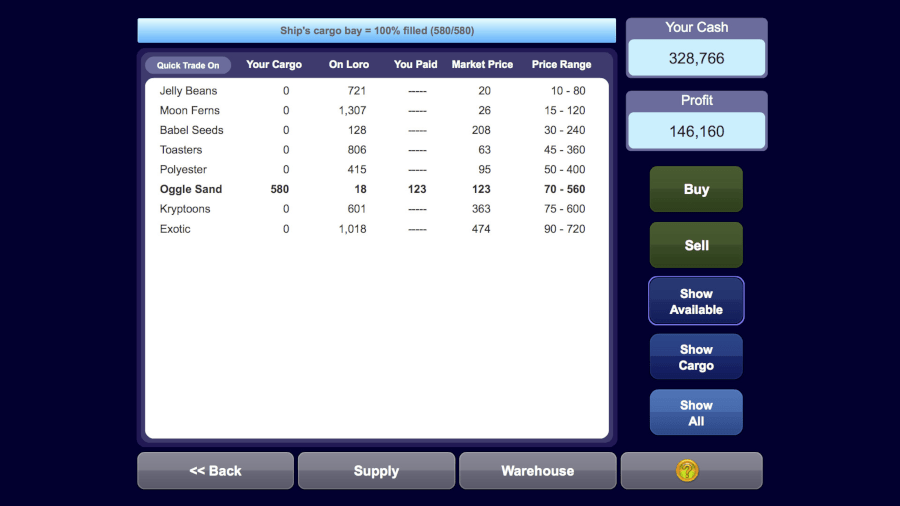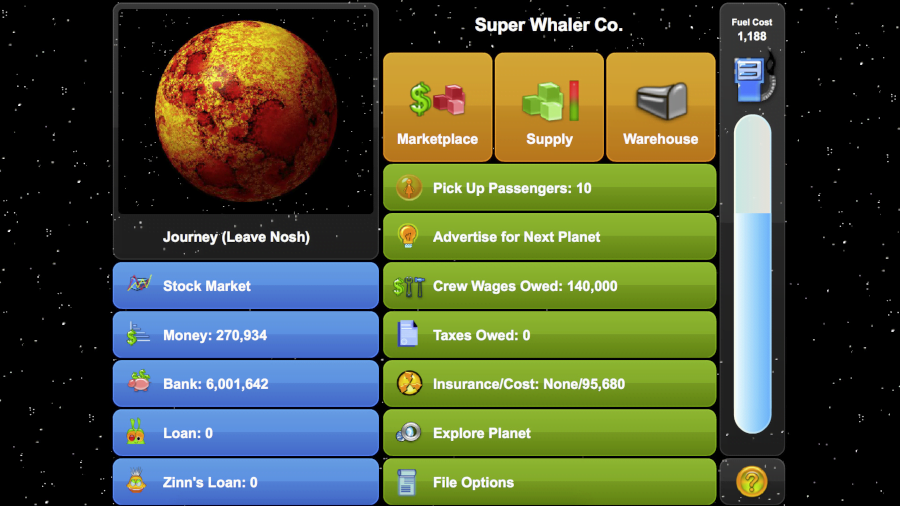In 1994, the videogame company Lavamind released the game Gazillionaire, which was in its purest form a sort of spreadsheet software with a random number generator built in. A bunch of trading companies kick off at the same point in time engaging in transport and trade. You go to a planet, which has its own weirdo economy and its own current supply and demand of goods, buy what you want, sell what you want, and head off to a new location to make a profit on those goods. There are all layers of complexity here, with things like warehousing and random events along the way, and every planet has its own specialised services and its own stock market you can use to invest in.
And it looks
like
this.
There’s an impulse when you talk about older videogames to talk about them with the assumption that there’s something about the games of the past, something about those games that can hook into your mind and captivate you regardless of how the game looks, or how its older systems might be pretty rough. Interface is a big one — a lot of games from this period predate the development of even standardised mouse behaviour! I don’t want you to look at this game and think, oh hey, Talen likes this game a lot, there must be something here.
There isn’t.
I promise you, there isn’t. Gazillionaire is not a game with some incredible deep-set mechanic that you have to marinate in to really appreciate. It is a game of unfair surfaces and entirely random opportunities. It is a very slow lottery ticket, where you’re kind of just hoping to not get unlucky in the right chain of events while you do your chores. It is a gameplay loop that is so fast and so meaningless you actually zip through whole planets without noticing them. The game has a system for making it so you don’t need to engage with chunks of interface and flavour because the game is well aware you don’t care, you just want to do things and get to the next turn.
You could probably remake Gazillionaire very easily. I sometimes wonder about how hard it would be to make a version of it with stock assets that doesn’t look awful. I’ve even considered how much this game could be replicated by something I know how to use, or how hard it would be to learn a software system that lets me make a game like Gazillionaire. I even made a version of something in it, in my game Freight Expectations. What that game has going on is a relationship between supply and demand and funny cargo material terms, but it lacks things like the random events in this game, and it lacks the game’s scope – you don’t choose where you go to trade.
Why does it look like this? It looks like this because it was made in 1994 by a tiny development team using a programe like MS Paint. No jokes. The art assets haven’t been updated, and quite frankly, I’m kinda glad of it. This is a franchise with the kind of art budgets that quietly looks like it’s one suggestion away from using Midjourney to update all of its assets, if only that spending that much time would be more money than Gazillionaire deserves.
Gazillionaire is a game that’s undeniably a product of its time. Its original incarnation worked by using the Windows 3.1 interface to put everything in its own unique window, with its own scrollbar. The game was made for an interface 320×240, which is this big:
The sounds in the game were .wav files, optionally stored, and whenever you did something that caused a sound effect (which included the ‘whoosh’ of travel and the “Ahah!” of Mr Zinn’s loan repayments), the game would seize for a moment because it was loading an application to play the sound, then closing it. This meant that paying off your loan was a high priority because it sped up the game in terms of loading time. I wonder if this game helped build in me the fear of ever getting loans because interest rates feel like they get away from you inherently. Oh wait that was probably the conservative Christian upbringing.
When I found out that it’d been ported to Steam, I was pretty excited because I thought that I could return to this game, this game that I had played as a kid and I could finally get around to finishing it. After all, I remembered really liking it! In fact, I remembered wanting a game like it, something where I could Just One More Turn for a bit, and, haha, now I was an adult, with the full version of the game, I could probably finish it properly, right?
right?
Once I finished balking at the idea of spending $30 on a 30 year old game that still looked awful and wasn’t available as abandonware any more (and I’ve got my own beef about that), I got it installed, played through it and decided to make good on a promise of decades past.
Reader, I still haven’t finished a single game of Gazillionaire. I’ve found the way the game is unwinnable and quit, I’ve run out of steam on a game, and I’ve found myself spending so much time on it that I quit the game and leave it! It is a game that I realised I was playing as part of an avoidance loop. That sometimes, I play a game like this, a game that’s fast and easy to play, and then find that I’ve spent an hour doing it in which I can’t remember anything I’ve done. I have been playing a single videogame for nearly thirty years at this point and I do not think I’ve ever finished a single play-through!
I don’t have it installed on this computer right now because I wanted to stop getting distracted by it!
Games let us learn about ourselves.
I learned I’m kinda bad with money and also, I fall into a particular kind of mental rat trap, very easily.


